
94% of researchers rate our articles as excellent or good
Learn more about the work of our research integrity team to safeguard the quality of each article we publish.
Find out more
ORIGINAL RESEARCH article
Front. Robot. AI, 28 September 2022
Sec. Robot Learning and Evolution
Volume 9 - 2022 | https://doi.org/10.3389/frobt.2022.970890
This work focuses on generating multiple coordinated motor skills for intelligent systems and studies a Multi-Expert Synthesis (MES) approach to achieve versatile robotic skills for locomotion and manipulation. MES embeds and uses expert skills to solve new composite tasks, and is able to synthesise and coordinate different and multiple skills smoothly. We proposed essential and effective design guidelines for training successful MES policies in simulation, which were deployed on both floating- and fixed-base robots. We formulated new algorithms to systematically determine task-relevant state variables for each individual experts which improved robustness and learning efficiency, and an explicit enforcement objective to diversify skills among different experts. The capabilities of MES policies were validated in both simulation and real experiments for locomotion and bi-manual manipulation. We demonstrated that the MES policies achieved robust locomotion on the quadruped ANYmal by fusing the gait recovery and trotting skills. For object manipulation, the MES policies learned to first reconfigure an object in an ungraspable pose and then grasp it through cooperative dual-arm manipulation.
The re-usability of control policies is a challenging research area in robotics. Task-specific controllers and learned policies have been developed to achieve a wide range of tasks, such as locomotion (Bellicoso et al., 2018; Hwangbo et al., 2019) on quadrupeds, as well as manipulation of objects (Levine et al., 2018). To create useful versatile robots, the ability to perform multiple tasks is essential, however, combining and reusing these policies in a unified manner remains an open question. This is because a learned policy is trained specifically to solve a particular task which has limited applicability to transfer such a single-skilled policy to other tasks. Having a control policy applicable to other tasks commonly requires redesigning or retraining the policy.
This work investigates a systematic approach to formalise the synthesis of multiple learned policies—a multi-expert synthesis (MES) approach that can produce versatile robotic capabilities, in which a high-level behaviour policy recombines multiple skills and fuses more flexible ones, using specialised experts based on the observation of states and task. Here MES is defined as the process of combining or blending expert skills in a latent space. This will produce a multi-expert policy, where a high-level behaviour policy selects the appropriate experts according to the real-time state observation.
The essential principle of multi-expert synthesis lies in designing a hierarchical control architecture where non-relevant information is coordinated and hidden across the layers: while the high-level behaviour policy requires task-relevant information, e.g., distance to a goal or pose of the object to grasp, the low-level expert only requires the proprioceptive state of the robot. Thus, experts focus solely on performing their particular skills, while the high-level policy is responsible for drawing from the experts’ skills and completing the task.
This idea originates from Hierarchical Reinforcement Learning (HRL) (Barto and Mahadevan, 2003). In HRL, for discrete and tabular cases, temporal (Sutton et al., 1999) and state abstraction (Dietterich, 2000) determine the information that the components receive. Despite the advantages of encoding non-relevant information across layers, composing and synthesising expert knowledge is not possible in the standard HRL framework since only one expert can be selected at a time. This problem is addressed by learning continuous latent variables that blend the experts in a latent space (Haarnoja et al., 2018a; Merel et al., 2018b).
The traditional approach for the latent space blending is the Mixture of Experts (MoE), where the outputs of individual experts (actions) specialized on sub-problems are combined by a gating function (Jacobs et al., 1991). The core idea of MoE, combining the outputs of experts via a gating network, has been adapted in the areas of machine translation (Shazeer et al., 2017), computer vision (Chang et al., 2018), robotics (Mülling et al., 2013), Reinforcement Learning (RL) (Sun and Peterson, 1999), and Computer Graphics (Peng et al., 2019). However, MoE has limitations known as expert imbalance—a form of mode collapse that arises due to the lack of diversity across experts (Shazeer et al., 2017; Zhang et al., 2018).
Alternative to MoE, the Multi-Expert Learning Architecture (MELA) has been proposed, where the latent space is constructed by blending expert network weights leading to a higher-dimensional latent space representation of the multi-expert network than MoE (Yang et al., 2020b). It has been shown that MELA avoids the expert imbalance problem, and provides a framework to use experts for learning diversified skills as well as adaptive behaviours on a quadruped robot.
In this work, we present a systematic approach to best achieve MES and propose algorithms that address two key problems in multi-expert methods: 1) how to select the correct state space representation for the MES policies; and 2) how to avoid the lack of diversity across experts leading to expert imbalance. We will show the results of multi-expert policies for both quadruped locomotion and cooperative bi-manual manipulation (Figure 1).
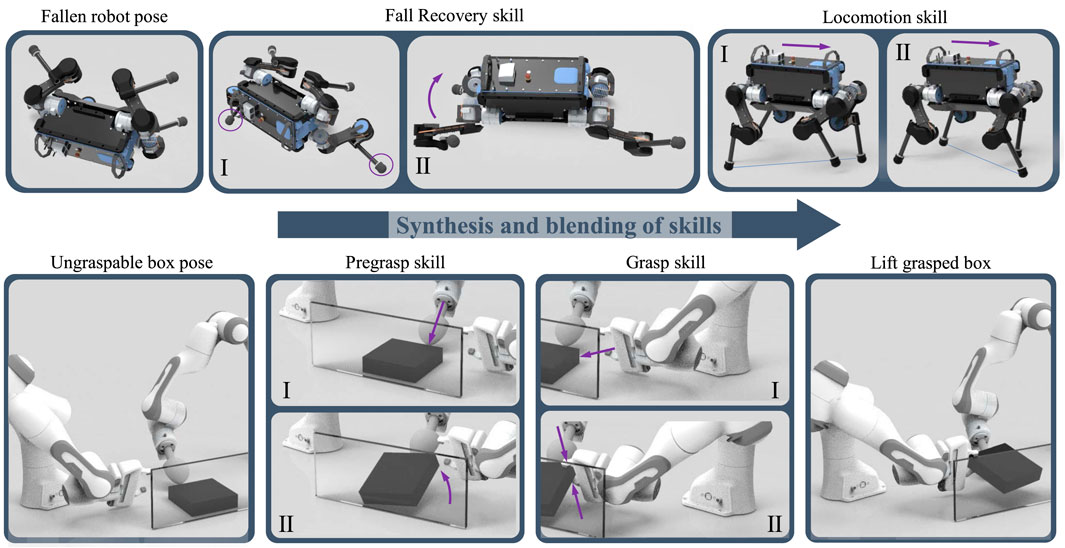
FIGURE 1. Synthesis of expert skills using Multi-Expert Synthesis. Top: Versatile locomotion by recovering from a prone position first and then transitioning into trotting. Bottom: Dual-arm cooperative manipulation, where the object is first reconfigured by the left hand into a graspable pose and then grasped by the right hand.
Specifically in MES, where every expert and the gating network has an individual state space, to correctly design the state space is crucial and non-trivial: missing key state variables will prevent the policy from learning the right action; whereas having too many and unrelated states will result in slower learning, large variances in the reward signals, and higher probability of converging to local minima (Garcıa and Fernández, 2015).
Our proposed procedure addresses this problem by the automatic selection of task-relevant state variables. Traditionally, the state space is designed relying on domain knowledge, and extensive trial and error to find a state space representation that yields highest performance. However, with an increasing amount of experts for different skills this becomes time consuming and potentially infeasible. Our proposed automatic state space design process mitigates the aforementioned state space issues for MES, where multiple state spaces need to be designed for the individual experts and gating network.
In the context of MES, our proposed method to explicitly enforce diversity among experts allows multi-expert methods in general to not suffer from expert imbalance. In multi-expert systems, a common problem known as expert imbalance occurs. This is because when one expert is over-prioritised by the behaviour network, it results in downgrading of other experts and the inability to learn distinct expert behaviours.
Our contributions are summarised as follows:
1. A systematic design for Multi-Expert Synthesis (MES) enabling learning of skill coordination and effective synthesis of multiple experts during tasks.
2. Formulation of a state selection algorithm that uses the learned state value function to quantitatively identify essential states and rule out task-irrelevant variables.
3. A proposed explicit enforcement of diversity among multiple experts by maximising their discriminability.
4. Applicability of the proposed methods for MES to achieve motor skill synthesis in both robot locomotion and manipulation.
We validate the MES approach in two distinct domains of robotic skills: locomotion and manipulation. For the validation on a quadruped robot, we show that gait recovery and locomotion can be synthesised to achieve robust locomotion (Figure 1 Top). Furthermore, our method can be used for cooperative dual-arm manipulation (Figure 1 Bottom) to grasp an object from a previously ungraspable configuration. The effectiveness of the trained multi-expert policies were validated in a variety of test scenarios in both simulation and real-world experiments.
Following, we first present related work (Subsection 2). Next, we demonstrate how expert behaviour is obtained (Subsection 3). Next, we present MES, the state selection process, and the types of multi-expert policies in (Subsection 4). The results using MES for a quadruped and dual-arm, and a comparison between MoE and MELA is conducted in Section 5 and Section 6 respectively. Lastly, we conclude the work in Section 7.
Model-based control methods have been widely use for robotics tasks, such as locomotion, manipulation, and whole-body control (Siciliano and Khatib, 2016). In particular, recent optimisation based approaches enabled robots to plan (Winkler et al., 2018) and robustly realise planned motions (Kuindersma et al., 2016) under constraints. This paradigm of using optimisation to first plan and then robustly track the planned trajectory has found wide application in the control of floating-based robots (Feng et al., 2015; Johnson et al., 2015).
Despite a wide range of applications and problems solved through existing control methods, the requirement of large amounts of computation power for large-scale optimisation problems, dependence and necessity of accurate models, and their limitation to generalise under uncertainties remain a challenge. To this end, learning based methods offer an alternative paradigm by learning through data while only specifying high-level objects instead of detailed mathematical specifications of the physical environment. Beside optimisation methods, such as genetic algorithms (Mitchell, 1998), evolutionary optimisation (Ha and Liu, 2016), or Bayesian Optimisation (Snoek et al., 2012), Reinforcement Learning (RL) (Sutton and Barto, 2018) has been the main approach to solve problems which are difficult for classical control methods. While gradient-free optimisation methods have been mainly used to optimise for the parameters of a controller (Rai et al., 2018) or a model (Yuan et al., 2019), RL is learning a parametrised function representing both the control policy (Yang et al., 2020a) and the model (Sutton, 1990).
For complex tasks, such as continuous control in robotics, Deep Neural Networks have been used as function approximators for the actor and critic, opening the field of Deep Reinforcement Learning (DRL). In robotics, DRL has been used on problems that are hard to solve using classical control methods, such as control of life-like locomotion of humanoids (Yang et al., 2020a) and animals (Yang et al., 2020b), fall recovery for quadrupeds (Hwangbo et al., 2019), and hand-eye coordination for grasping (Levine et al., 2018).
Due to the data demanding nature of DRL algorithms, the policies are learned in simulation removing the risk of damaging the robot and leveraging advances in computation speed and parallel computing allowing fast collection of samples. To ensure that the simulation to reality (sim2real) transfer of the policy yields similar performances in reality as in simulation, the fidelity of the simulation can be increased (Tan et al., 2018; Hwangbo et al., 2019) or the policy can be trained to be robust to uncertainty (Peng et al., 2018b).
To complete multiple tasks using one unified framework, hierarchical control structures can be used to select appropriate sub-policies through a high-level gating mechanism. In HRL, complex tasks are solved by using existing knowledge of experts through temporal abstraction (Sutton et al., 1999). In its original form, temporal abstraction is achieved by having the top-level policy selecting among options, which are sub-policies that continuously perform one action over a period of time (Sutton et al., 1999).
With the advent of Deep Learning and Deep Neural Network, DRL has been used to extend the discrete tabular HRL concepts into the continuous control domain. In the context of multi-expert learning and multi policy composition, this led to frameworks where low-level experts encode motion primitives or skills, while a high-level policy selects the expert (Frans et al., 2017; Merel et al., 2018a). Alternative to learning a high-level policy to select appropriate motion primitives, COCoMoPL (Clever et al., 2017) proposes a framework, where near-optimal motion primitives are learned and synthesised into a motion as weighted combination of these motion primitives.
In (Kumar et al., 2018), a method is proposed that does not synthesise expert skills into a unified policy, but rather expands the existing skill by decomposing the task into simpler subtask and training a local policy for the subtasks.
A modular framework is proposed in (Lee et al., 2018), which learns transition policies that connect primitive skills to complete sequential tasks. An extended work in (Lee et al., 2019) uses the modular framework to learn to coordinate the learned primitive skills for task completion. In (Qureshi et al., 2019) a method is proposed that learns task-agnostic skills using their composite to solve new tasks in an HRL fashion.
In contrast to aforementioned methods that select one sub-policy, the outlined MES in this work continuously blends all experts. From a practical perspective, this allows the multi-expert policy to choose latent skills from multiple experts instead of just choosing a particular skill from one expert. Furthermore, MES continues to train the experts alongside the high-level behaviour network, such that the learned expert skills can be specialised and can learn new skills, while gating network blends the experts’ skills. To increase the usability and performance of MES, this work provides two novel algorithms for automatic state selection and enforcing expert diversity yielding higher performances and faster development times.
For the multi-expert learning structure, individual narrowly-skilled experts need to be obtained. In this work, two procedures are presented to obtain expert behaviours: 1) autonomously learning a policy through interactions with the environment and 2) learning to imitate a reference policy.
In order to solve a task, a reward, whose maximisation leads to task completion, needs to specified. If the policy is autonomously learning from scratch, methods from Deep Reinforcement Learning are deployed to maximise the reward. For imitation learning of a user-designed controller, a controller is designed first, and then a policy represented as Neural Network (NN) is trained to imitate the controller as closely as possible while maximising a task reward.
Using model-free DRL algorithms to learn a policy from scratch is helpful when the solution is not straightforward. On the other hand, using an existing manually designed controller gives more certainty of behaviours over the robustness, stability, and performance. Thus, combining control design for well-defined tasks, such as locomotion, and leveraging the exploration of learning methods for tasks in ill-defined or uncertain states and environments, such as fall recovery from any pose, provides experts for a variety of cases.
In the following, we will first introduce the control structure how the robot is controlled to achieve its task, and then present the procedure to learn experts through DRL. Lastly, we will show how an expert can be obtained from imitation learning.
The control structure of the robot consists of two control loops: high-level behaviour control, and low-level joint impedance control (Figure 2). The high-level behaviour control loop governs the behaviour of the robot at 25 Hz by mapping the robot’s states into actions for the joint impedance controller, which runs at a frequency of 400 Hz. From measured joint positions and velocities, the joint torques are generated in a proportional-derivative control law:
with joint index i = 1, …, N, joint torque τ, proportional gain KP, derivative gain KD, target joint position qd, measured joint position q, and joint velocity
Here, a low-pass Butterworth filter is applied respectively on the feedback state and actions in the high-level control loop. Filtering the robot state allows reducing sensor noise while also providing smoother states for the Neural Network, thus yielding smoother target actions. Besides, to match the torque tracking bandwidth of the actuators, desired actions of the behaviours control are low-passed filtered and limited to those that are able to be executed by the actuators.
To enhance the smoothness for realisable control actions on robotic systems, an additional smoothness objective is added to the standard maximum entropy objective (Ziebart et al., 2008) of SAC:
with stochastic policy π, smoothness regularisation parameter λ, deterministic policy μ, maximum entropy objective JSAC(π), and smoothness loss Jsmoothing(μ).
The maximum entropy objective JSAC(π) is defined as:
with state st, action at, temperature parameter α, expectation
with minimum policy entropy threshold
The smoothing loss Jsmoothing(μ) encourages the policy to generate deterministic actions μ(st) that are close to the current, measured state q:
Directly embedding a regularisation loss on the optimisation level yielded better smoothness, compared to the additional regularisation terms in the reward.
In the SAC algorithm, the parameters of three function approximators are learned: parameters ϕ of the policy πϕ, parameters θ of the soft action-value function Qθ, and parameters ψ of the soft state-value function Vψ.
After applying the reparametrization trick, the policy parameters ϕ can be learned by minimising the objective Jπ(ϕ) (Haarnoja et al., 2018b):
The policy πϕ is re-parametrised through a neural network transformation: the action
For stability of the training, the more conservative estimation between two Q networks
Minimising Bellman residual JQ (θj) with bellman equation
The parameters
Correctly designing state space
In Section 4.2 of the main manuscript, we proposed a systematic approach to choose the correct subset of states among all possible variables. Figure 3 depicts a non-exhaustive set of potential states for floating-base and fixed-base systems, such as quadrupeds and manipulators respectively.
For all physically measured quantities, a first-order low-pass Butterworth filter is applied to denoise. The cut-off frequency is individually set and is determined through a spectral analysis based on signals from the idle system.
For the choice of the action space
As the reward function governs the behaviour of the policy, ambiguously specifying the reward could lead to reward exploitation and potentially failures. Here, we formulate a set of physically-motivated reward terms ri for both floating-based and fixed-based systems.
The reward rt at time t is calculated as weighted sum over the individual reward terms ri with weights wi:
To both regularise and achieve desired values, a Gaussian Radial Basis Function (RBF)
with desired value xd and current value x. For regularisation terms, the desired value xd is set around the operating point. The width κ governs the tolerance δmax of the residual error, and is calculated as
Although there is no general rule for reward shaping—the process of adding and removing reward terms and tuning the relative weights between each other—the following guidelines can be considered and proved helpful during the process of designing policies for locomotion, gait recovery, pregrasping, and grasping on quadrupeds and dual arm manipulators respectively.
• High weights on goal related terms, e.g., small residual error between joint angles or poses for imitation terms, small distance to goal (grasping), or small residual error in body velocities (locomotion);
• Low weights on regularisation terms of physically meaningful terms. Regularisation on quantities, such as joint torque or joint velocity, or regularisation around nominal positions, proved helpful for stability, reducing and oscillation. This behaviour is similar to regularisation for stability and robustness purposes in optimisation in Robotics, e.g., Whole-Body Optimisation Yuan et al. (2019) or Trajectory Optimisation Winkler et al. (2018).
• The usage of reward terms that are non-negative or positive terms instead of negative terms should be chosen. Having negative rewards terms encourages the agent to terminate early in order to prevent culminating more negative rewards. Radial Basis Functions were found suitable as kernel and provides good gradients. Other non-zero kernels are suitable as well.
All single-task experts and multi-expert policies in this work are trained by maximising rewards to follow desired link poses, and regulate joint velocity and joint torque for smoothness in actions. The rewards used in this work can be found in Section 5.3 of the main manuscript, and a more detailed description for reward design can be found in (Yang et al., 2020a, 2018; Hwangbo et al., 2019; Sun et al., 2020).
Designing training procedures for the DRL agent is required for both the success and high quality policies. We applied four techniques during the training of the policy: early termination, reference state initialisation (RSI), guided curriculum, and dynamics randomisation.
Early termination stops an episode when meeting an early termination criterion and is therefore used to discard irrelevant and skewed samples. Early termination biases the policy to avoid bad states as the agent cannot collect any further rewards if the episode is terminated. Early termination criteria are set for states that have self-collision or unwanted collisions with the environment. For floating-base systems, once the height of the base falls below a threshold, the episode is terminated.
In order to generalise well across the whole state space and thus training a robust policy, the robot is initialised in reference states that are task-relevant but rarely encountered (Peng et al., 2018a). Reference states include failure states, local minimum solutions, or imitation frames (see Section 3.3).
For best performance of the policy, curriculum for the learning process is applied. The curriculum aims to guide the policy by gradually increasing the difficulty of the task. In general, if the task difficulty is too high, the policy converges to a locally optimal solution. An increase in the difficulty can be implemented on reward weight, e.g., increasing importance on regularisation weights (Hwangbo et al., 2019), or in the amount of tasks which the policy needs to complete, e.g., initially standing for a quadruped robot and gradually adding locomotion tasks while withstanding disturbances or an increase in dynamics randomisation (Yang et al., 2018). In our setting, the robot is being pushed during training as in (Yang et al., 2018) to provide additional robustness towards uncertainties.
To increase the robustness of the policy against model uncertainties and to improve the transferability of policies across environments, we applied dynamics randomisation (Peng et al., 2018b) on the robot model. At the beginning of every episode, the parameters of the robot dynamics are uniformly randomly sampled within the range specified in Table 1 in the Supplementary Materials.
As an alternative to learning via DRL from scratch, we use imitation learning to train a DRL agent by imitating a reference trajectory. In the following, we present a learning scheme for quadruped locomotion that encourages the agent to imitate a reference motion while solving a task as described in Section 3.2.3.
Four quantities are used for the learning algorithm to imitate: joint positions, joint velocities, relative end-effector positions, and contact states of the feet. The references are time-based trajectories obtained from an optimal trajectory generator for the Centre of Mass (CoM) and the whole-body controller that tracks the CoM trajectory (Bellicoso et al., 2017; Yuan and Li, 2018). For imitation learning, the reward is modified. The new reward consists of a task reward rtask, and an imitation reward rimitation:
with weights wtask, wimitation corresponding to the importance of task completion and imitation quality respectively.
The imitation reward rimitation is calculated as the weighted sum of four sub-rewards:
The joint position rq, joint velocity
To prevent temporal ambiguity during the imitation of a time series of reference frames, a variable representing time needs to be provided, similar to (Peng et al., 2018a; Yang et al., 2020a). Because of the periodic nature of locomotion, a periodic phase vector ζ is formulated as:
where Ω normalises the period to match the periodicity of the reference time series, and the representation using ζ is compatible with NN instead of using a monotonically increasing time as a variable.
For RSI, the robot’s joint position and joint velocities are initialised according to a uniformly random sample from the reference trajectory.
In the following, we outline Multi-Expert Synthesis (MES) and elaborate how the trained experts are embedded in MES. We further formulate an automatic State Space Selection Process that was used to determine the state space of all policy networks. Lastly, we present how to enforce diversity among experts and tackle the problem of mode-collapse.
The two-stage training process for MES policies is depicted in Figure 4. In the first stage, individual, single-skilled experts are trained by solving a particular task as described in Section 3. In the second stage, the high-level behaviour network is trained alongside the pre-trained experts. While being synthesised by the high-level behaviour network, the pre-trained experts in the second stage are further fine trained which allow all experts to synergise with one another.
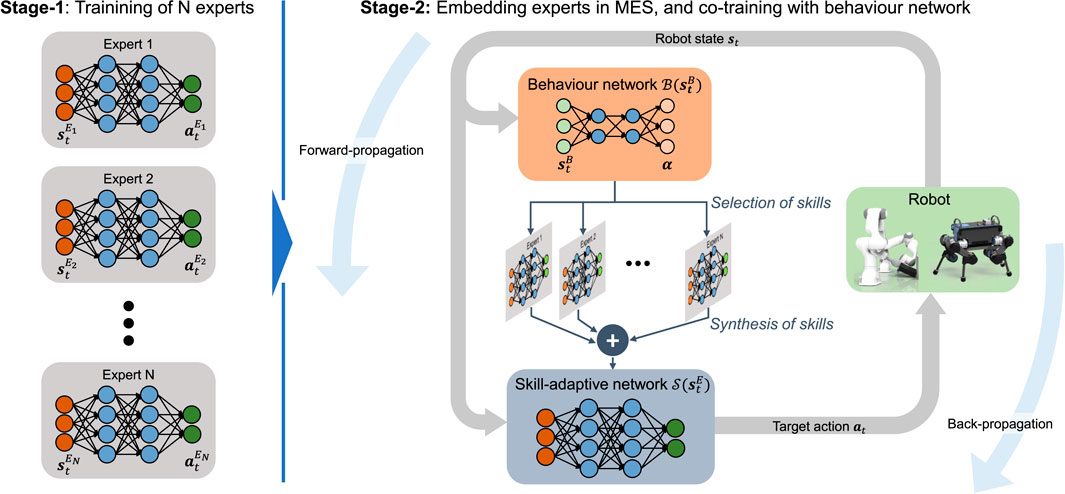
FIGURE 4. Multi-Expert Synthesis trained in a two-stage curriculum. Experts are pre-trained in Stage-1 and co-trained in Stage-2 alongside a Behaviour Network.
Based on the behaviour state
For this work, we consider two approaches—MELA and MoE—to achieve MES. The difference between MELA and MoE lies in how the outputs
For MELA, the outputs of the behaviour network α blend the network parameters of the experts (Yang et al., 2020b), while MoE α uses the weighted sum of the actions ai of all expert networks.
The skill-adaptive network’s parameters
for the i-th expert, neuron n in layer l, and blending weights
As the skill-adaptive network’s parameters are a linear combination of all expert parameters, which have the same amount of neurons and layers. Thus, to accommodate different expert network sizes, the expert network size in Stage-2 is augmented (Figure 5). The amount of layers and neuron per layers are the same as the largest network. To keep the input-output behaviour of the augmented neural network unchanged, all weights
with n neurons in layer l, activation function f (⋅), weight
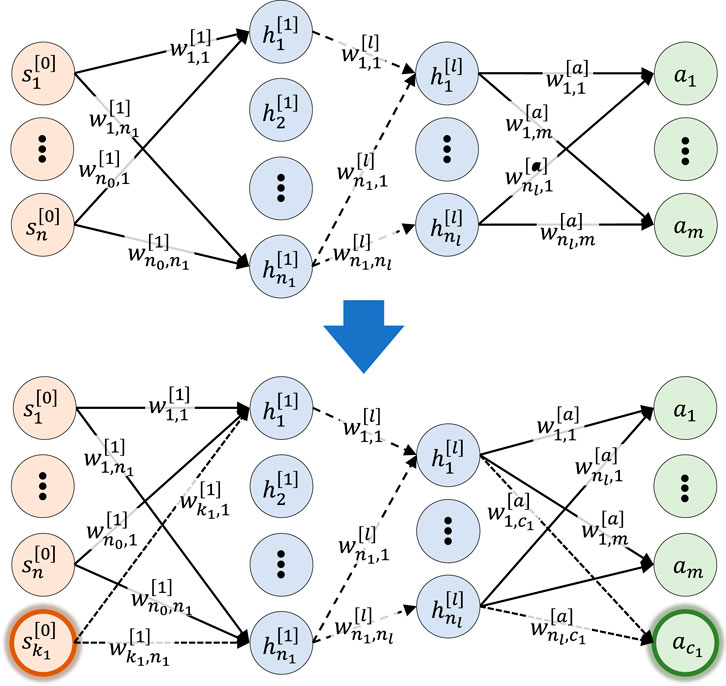
FIGURE 5. Augmented expert network. Top: Originally trained expert. Bottom: Augmented expert network. All neurons are fully connected including bias terms but omitted for clarity.
For MoE, the actions a are calculated as weighted sum from the expert’s actions ai and the behaviour network’s output
where N is the number of experts with corresponding weights αi on the output actions ai. Consequently, compared to MELA, the dimensionality of the latent space of MoE is much lower by orders of magnitudes.
In the following, we present the systematic selection of the state space based on their relevance to the task. The core idea of the state selection process is to check whether the removal of a sub-state space
The value function
More specifically, we have:
where
To describe the various state quantities, we use the following notation. Symbols written in bold denote a state space
In Algorithm 1, we outline how the state space is selected. Algorithm 2 describes the practical implementation of (18) to determine relevant state variables. For selecting relevant sub-state spaces (Algorithm 1), the state space is repeatedly reduced using Algorithm 2. During every iteration, value function Vπ(s) and policy π(a∣s) are trained (Section 3) using states
In our work, the task-relevant state space is usually found after one iteration. However, when no domain knowledge for the initial state space
Algorithm 1. Pseudo code for relevant state selection.
Algorithm 2. Pseudo code for selecting relevant state variables.
For the reduction of the state space in Algorithm 2, two thresholds δrelevant, δrequired are set. The relevance of sub-state space
In multi-expert systems, expert imbalance commonly occurs. For tasks requiring multiple experts as shown in Section 5.4, expert imbalance leads to the task not being completed and a local minimum solution.
To prevent expert imbalance, we encourage the experts to learn easy-to-discriminate and diverse skills by including a discriminator objective (Eysenbach et al., 2018) in the DRL objective (see Eq. 2):
with learned discriminator qϕ(z∣sD) parametrised by weights ϕ and one-hot vector z indicating the skill. The discriminator estimates the likelihood of skill z conditioned on state sD, and is trained to minimise the cross entropy
The diversity objective 19) encourages the policy to produce states as distinct as possible, so that the discriminator can easily estimate the skill z based on the state sD. Note that the state
In this section, first we outline the setup of the learning framework. Second, we present results of our proposed state selection process. Third, the expert behaviours of MES are shown. Next, Multi-Expert results on the quadruped and dual-arm robot are reported. Lastly, we show the robustness and ability of MES to generalise across environments.
We demonstrate that our state selection process finds the state space yielding the highest reward and is used to design the state space for all MES components. Furthermore, MES learns robust multi-expert policies that are effective from simulation to the real robots and in unseen test scenarios.
All policies were trained in PyBullet (Coumans and Bai, 2016) on a commercial computer (CPU: i7-7700K, GPU: Nvidia GTX 1080Ti). The expert and multi-expert policies converged after 1000 and 2000 (Figure 13) epochs respectively. Every epoch consisted of 1000 samples using the sample collection depicted in Figure 2 with 25 samples collected per second.
All networks are two-layered, fully connected Neural Networks with 256 neurons in each layer. Rectified Linear Units (ReLU) were used as activation functions. The standard parameters of SAC were used as in (Haarnoja et al., 2018b).
We performed dynamics randomisation (Peng et al., 2018b) during the training (see Section 3.2.4) and transferred the policy from PyBullet to both Gazebo (Koenig and Howard, 2004) and the real robots. During training in PyBullet a range of values were used for dynamics randomisation (see Table 1 training in Supplementary Materials), and a larger range (see Table 1 testing in Supplementary Materials) was used in Gazebo, which show that the multi-expert policy is robust in presence of large physical discrepancies.
The state selection process described in Section 4.2 was used to design the state space for the experts and gating network for all policies. We demonstrate the state selection process and its effectiveness on quadruped locomotion and reach-grasp manipulation (see Section 5.3).
First, we determine the relevant state variables from a large set of potential state variables. Second, we show that our proposed method distinguishes between completely irrelevant state variables and potentially relevant state variables by adding 10 random variables to the state space. Lastly, we compare the performance of optimally selected state spaces and extended state space containing irrelevant state information based on quantitative performance and qualitative behaviour.
We chose and defined the state variables for initial state space
After one iteration of Algorithm 1 with threshold δrequired = 0.1, the least relevant state variables were found to be: joint velocity and torque, and end-effector force for locomotion (Figure 6 top left) and all state variables but the joint positions for manipulation (Figure 6 bottom left). By removing the least relevant state variables from the initial, extended state space
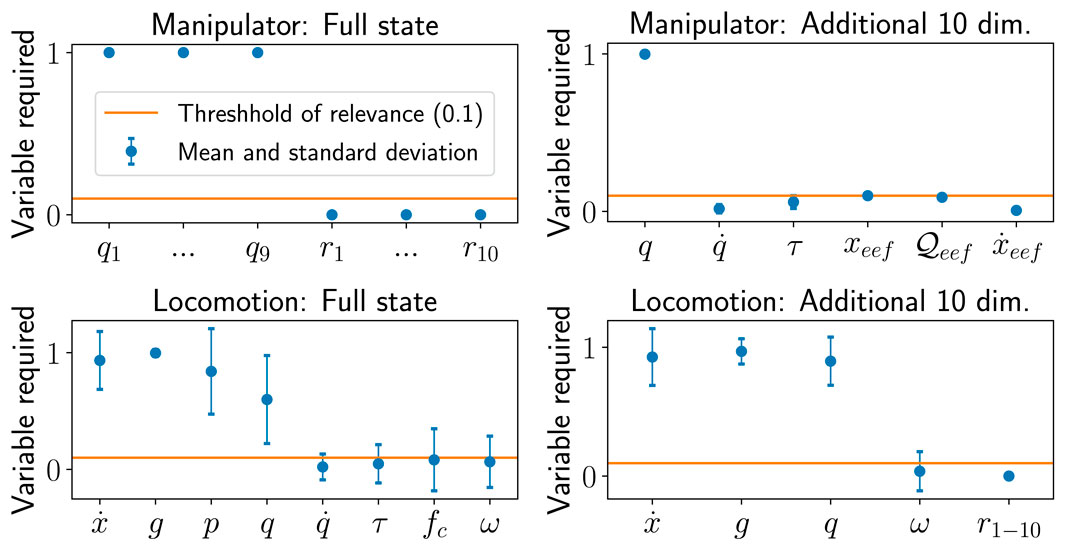
FIGURE 6. Results of state selection using large state space and 10 additional dimensions for locomotion and manipulation. Top left: Full state variables for manipulation, top right: additional 10 values as state variables, bottom left: full state variables for locomotion, bottom right: additional 10 values as state variables for locomotion.
The state selection process was further validated by adding 10 random variables ri, i = 1, …, 10 to the reduced state space. For every sample, the value of every random variable sextra,i was uniformly sampled sextra,i ∼ U ( −1, 1). All 10 random variables (Figure 6 top and bottom right) were identified to be irrelevant after one iteration of Algorithm 1.
Here, we define our formulation of reduced state space as the baseline, and those with all possible states as the extended state space including those irrelevant to the task, as found by our algorithms, for both locomotion and manipulation. We comparatively analysed the difference between the baseline and the extended state space representations in terms of the learning curves and the learned behaviours.
Our baseline state space converged to higher rewards in both locomotion and manipulation tasks (Figure 7). In contrast, the extended state space was easily stuck in local minima in almost 60% of the cases, leading to policies with lower return and the incompletion of the task. For a fair comparison, the local minima solutions that did not complete the task were not included in the learning curves.
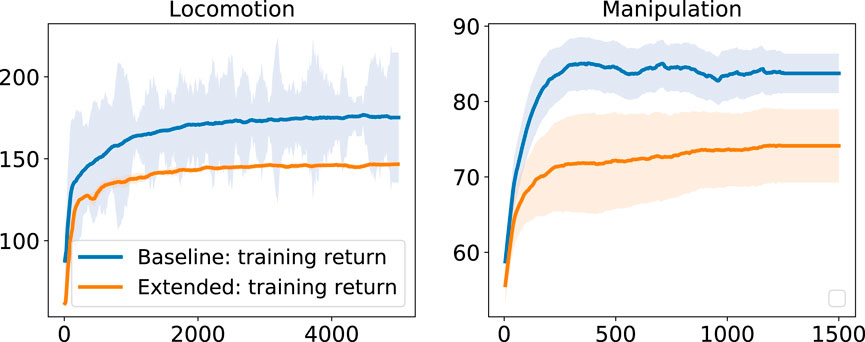
FIGURE 7. Performance for different state space configurations for locomotion (left) and manipulation (right).
Another difference in performance between baseline and extended state space is observed from the policy’s behaviours. While the extended state space representation completes the tasks, our proposed baseline performs better than the extended case. During quadruped locomotion the extended state space representation drifts in the y direction and is not able to encode the periodicity of locomotion (Figure 8). Besides, the manipulation policy exhibits oscillatory behaviour after grasping the object (Figure 9).
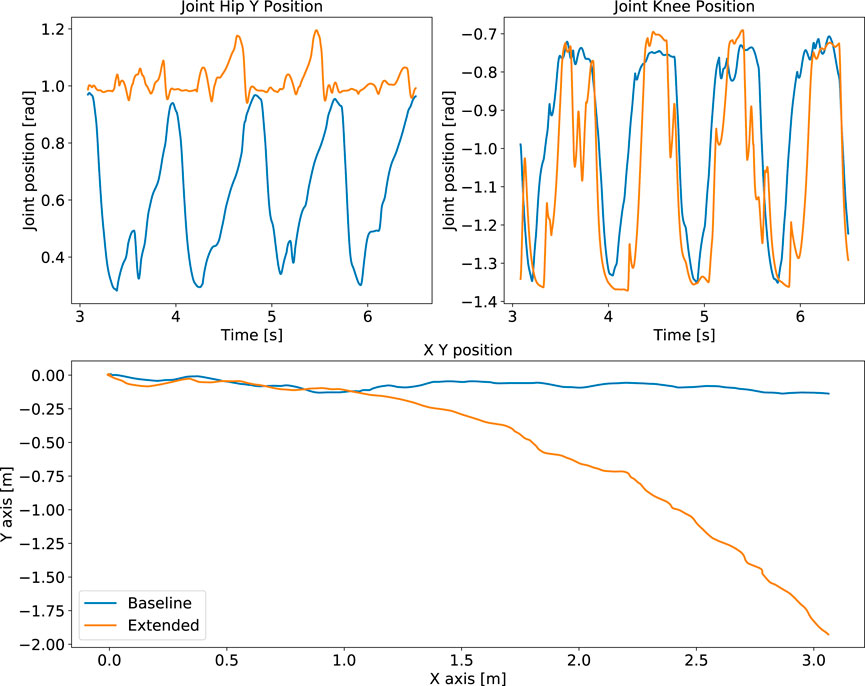
FIGURE 8. Locomotion performance: comparison of policies trained using the optimal baseline state space versus the extended states. Failure to capture periodicity (top) and drift of robot position (bottom) from the extended state space policy (orange), compared to our formulated baseline policy with optimal state space (blue).
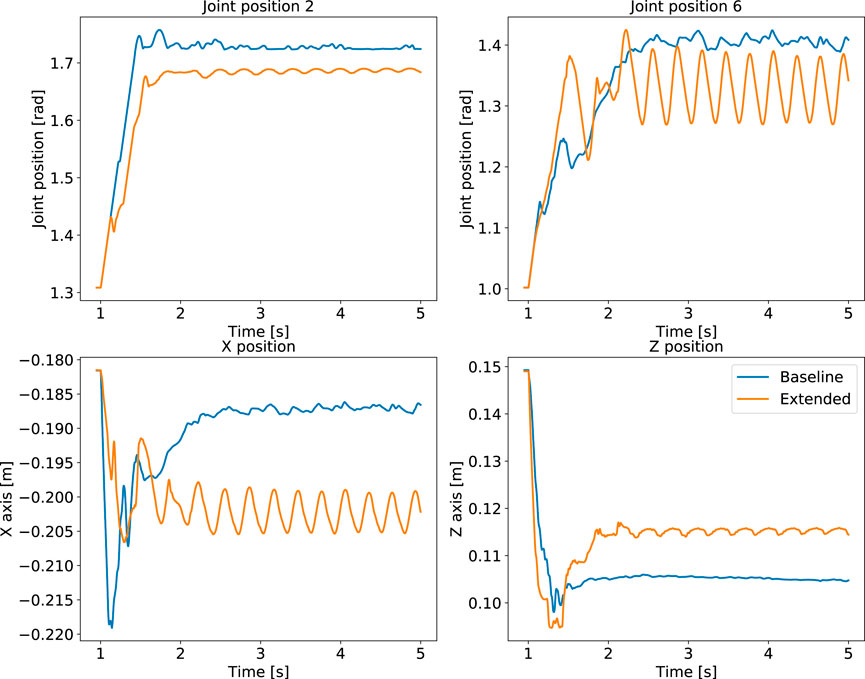
FIGURE 9. Manipulation performance: comparison of policies trained using the optimal baseline state space versus the extended states for. Oscillatory behaviour using the extended state space (orange), compared to our formulated baseline policy (blue).
Using the training procedure in Section 3, all experts were trained for the use in Stage-2 of MES (Figure 4). In Figure 10, two expert behaviours are shown: gait recovery and trotting. Please see the accompanying video for further details.
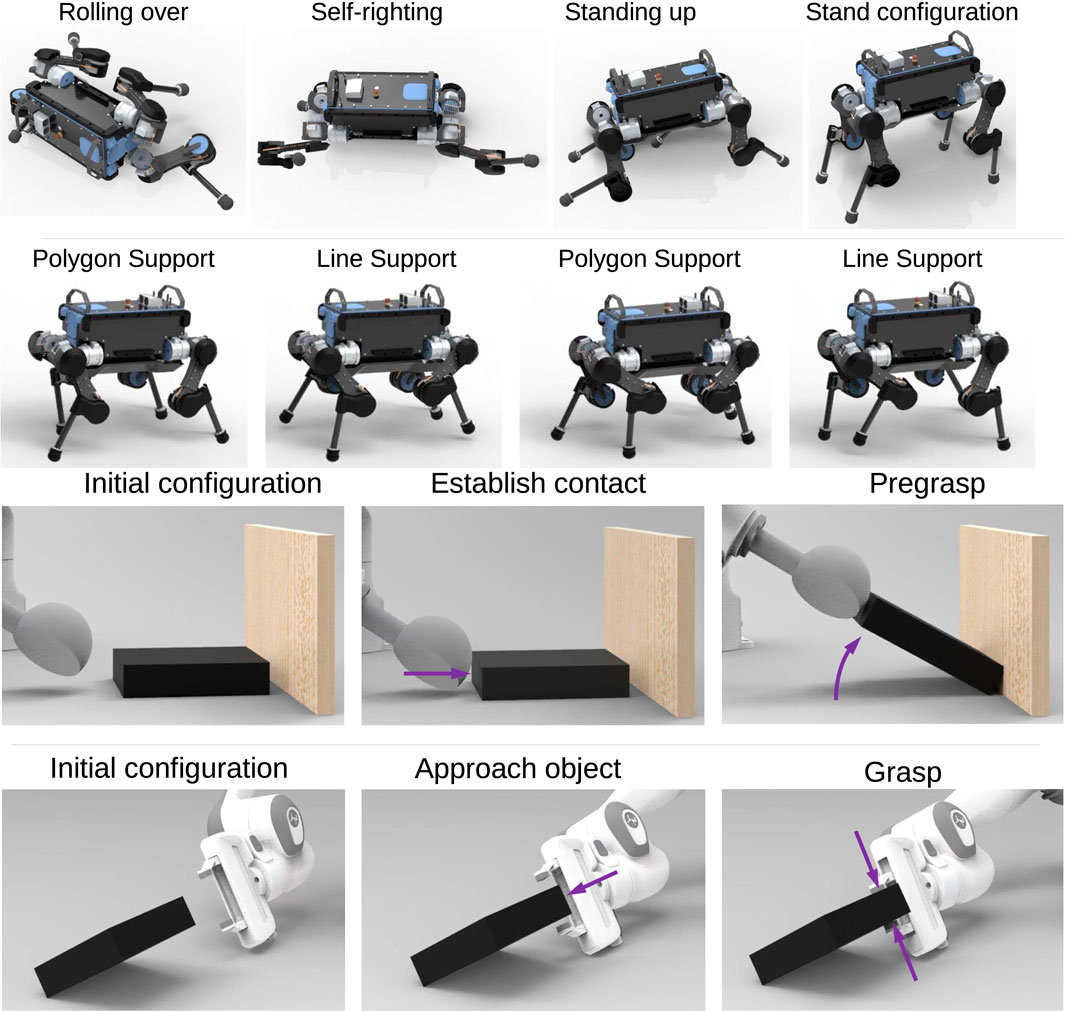
FIGURE 10. Expert policies for gait recovery (first row), trotting (second row), pregrasping (third row) and grasping (fourth row).
The gait recovery and trotting experts were trained as follows. The training of the gait recovery expert was conducted through directly specifying a reward, with which the maximisation leads to task completion. For trotting additional reference trajectories were provided for imitation (see Section 3.3). The weights of the reward terms can be found in Table 2 of the Supplementary Materials.
All reward terms were expressed as radial basis function (see Section 3.2.3) unless stated otherwise. For gait recovery and push recovery, the sagittal velocity xvel was set to zero; for the locomotion gaits, xvel was provided by the imitation data, and the lateral and vertical velocities yvel, zvel were zero. The unit gravity vector gL is the normalised gravity vector in the robot body frame. Regularisation was performed on the joint velocities and joint torques by using a zero vector as target value. For the imitation terms, the target values were provided by the imitation data from a trotting controller.
Early termination was conducted for all experts if the robot was in self-collision. For locomotion, the episode terminated early if any link but the feet was in contact with the ground or if the body height fell below 0.25 m. RSI was performed for both locomotion and gait recovery. For locomotion, the robot was spawned in joint states from the reference imitation data. For gait recovery, the robot was spawned in prone and supine body poses with random joint positions.
For dual-arm cooperation, pregrasping and grasping experts were trained (Figure 10). The state space of both manipulators were determined using Algorithm 1. For grasping, the state space
For pregrasping, the reward has a contact and object orientation term with weights wcontact = 1 and wobject = 3 respectively. A reward of 1 was assigned when the end-effector was in contact with the object. The residual error in (11) was calculated as max (θd − θ, 0) with desired orientation θd = 45°.
The grasping reward is the sum of finger contact and end-effector position reward with weights wcontact = 1 and weef = 1 respectively. A reward of 1 was assigned if both fingers were in contact with the object. A reward for the end-effector link being close to the desired position pd was assigned (Eq. 11). Early termination was performed in case of self-collision or if any link other than the end-effector was in contact with the object.
The previously learned expert skills are now used for MES to achieve robust locomotion and dual-arm manipulation. We choose MELA over MOE as the multi-expert framework because MELA yields better policy performance during domain transfer and is able to diversify experts better (see Section 6).
Two experts per skill were initialised for further diversification. Using the network augmentation shown in Figure 5, the expert’s state space can be preserved while being embedded in Stage-2 of MES. Early termination was applied in case of self-collision. The pose for RSI was uniformly sampled between prone positions and reference imitation trajectories.
For robust locomotion, the gait recovery expert reward rgr is used if the robot falls, i.e., the threshold in height pz < 0.4m or body orientation rpy > 20° is exceeded; and the locomotion expert’s reward rloco is used, otherwise. For the behaviour network’s state space, the state selection process results in sufficient forward velocity. The motion can be seen in Figure 11 and in the accompanying video.
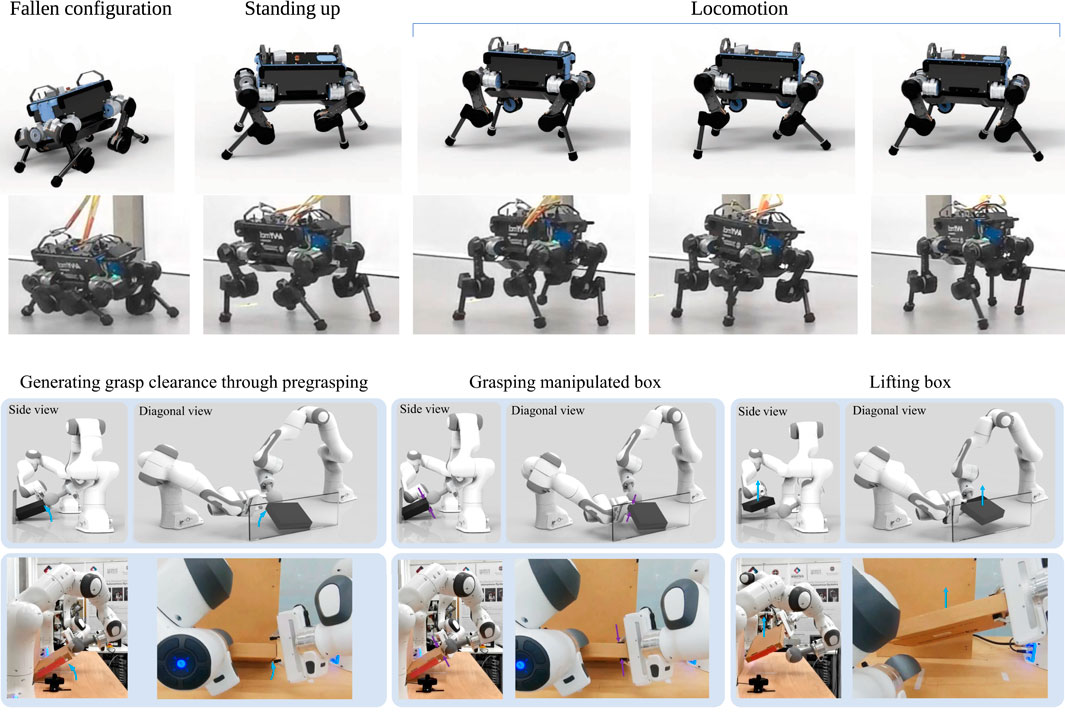
FIGURE 11. Multi-expert policies in simulation and on the real robot. Top: Robust locomotion of gait recovery from a prone position and smooth transitions to trotting. Bottom: Dual-arm cooperative manipulation and grasping.
The dual-arm manipulation results show how MES adapts the experts’ access to information using the network augmentation technique depicted in Figure 5. For the pregrasping expert, although the object’s orientation is relevant during the Stage-1 training, it became less relevant after co-training with a behaviour network in Stage-2. The relevance of the object’s orientation was determined by looking at the values of the weights and gradient related to the object orientation, which were almost zero. From the hierarchical structure, this is explainable since the behaviour network can access the object’s orientation and thus activate the expert accordingly.
We found that MES consistently adapted the experts’ requirement of state variables throughout all trained policies. The expert policies for the pregrasping and grasping task only used joint positions of the pregrasper and grasper respectively, while the behaviour network used the object’s orientation as state input. Backpropagation through the MES network allowed the experts and behaviour network to share the state information for completing the task. The coordinated motions can be seen in the bottom of Figure 11 and the accompanying video.
For validating how robust and versatile MES is, we deployed the multi-expert policies in test scenarios that have never been seen during training (see Figure 12, accompanying video). Specifically, we tested the policy under environmental and hardware uncertainties. The policies’ ability to robustly function in unseen environments and the successful transfer from simulation to the real world demonstrate that the learned MES policy is robust and can generalise across environments and domains with varying physics and dynamics properties.

FIGURE 12. Robustness under uncertainties and generalisation for locomotion (left) and manipulation (right) both on real robots and in unseen test settings.
The MES policies were tested under varying dynamics parameters from 50% to 150% of the mass and inertia of the robot links. For locomotion, the robot traversed test terrains consisting of a cluster of planks, slippery objects (Figure 12 left), and withstood large pushes on the real robot (see accompanying video).
For dual-arm manipulation, the environment was modified by using different objects and support bases. We replaced the flat wall with the grasper’s base as support (Figure 12 right) and a round wall (see video). We replaced the nominal box with a torus (see video) as the object. Despite altering the environment in which the robot interacts with different objects and support walls, the policy can still adapt and complete the task. Furthermore, the successful dual-arm cooperation was shown in real experiments (Figure 12 right), and under disturbances applied on the object (see accompanying video).
The multi-expert policy robustly completes the task under hardware uncertainties from actuators, sensors, and varying dynamic parameters, such as inertia and mass (see accompanying video). For both actuators and sensors, we tested three settings in simulation: adding Gaussian noise to the signal, setting the signal to zero, and randomizing the signal uniformly. Such setting corresponds to the actuators being corrupted by noise, jammed in a zero position, or receiving jerky commands. For the sensors, the measurements become noisy, zero, and erroneous respectively.
Despite the existence of hardware discrepancies, the multi-expert policy achieved stable trotting and completed lifting and grasping of the object. This shows the robustness of MELA as a feedback policy to realise different motor tasks, i.e., quadruped locomotion and bimanual manipulation.
MoE approaches have been reported to scale poorly for control of a high degree-of-freedom systems (Zhang et al., 2018; Yang et al., 2020b). The limited expressiveness of the low-dimensional latent space, i.e., the action space, causes an imbalance in expert behaviour that favours some experts and downgrades others (Shazeer et al., 2017; Zhang et al., 2018).
We compared MELA with MoE based on the task performance in quadruped locomotion and dual-arm cooperation. The learning curves can be seen in Figure 13.
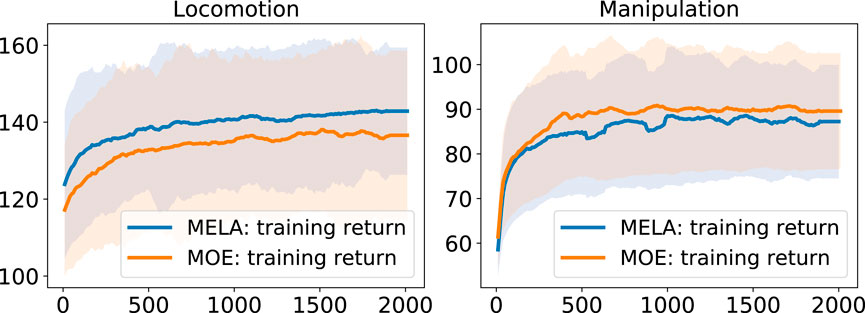
FIGURE 13. Comparison of learning curves of MoE and MELA. The learning curves are averaged over 5 separate training runs and the robot can stand with a reward higher than 100.
To analyse the transferability and robustness of MELA and MoE across domains, we validated the robust quadruped policy in a different physics simulation, i.e., a simulation to simulation (sim2sim) transfer from pybullet to Gazebo. Gazebo simulator was chosen because the same software infrastructure was used for running the real robot Anymal. The practical and common discrepancies in real world experiments that can cause poor policy performance (Peng et al., 2018b; Tan et al., 2018; Hwangbo et al., 2019) were introduced in Gazebo, including the mismatch in the physics model, signal noises, feedback latency, friction and damping, and drift in sensory measurements. All quantities used by the MES policies were directly measured and filtered from the robot, or obtained through the state estimation algorithm that runs on the real robot.
While both MoE and MELA can learn robust locomotion in the PyBullet simulation, only MELA was able to transfer the learned policy and perform successful trotting in both a different simulator Gazebo and the real robot. In contrast, MoE was not able to reproduce successful trotting across a different physics simulation or real system and environment, which was shown by a downgraded behavior of a dragging leg that caused a complete fall (see Figure 14 and accompanying video).
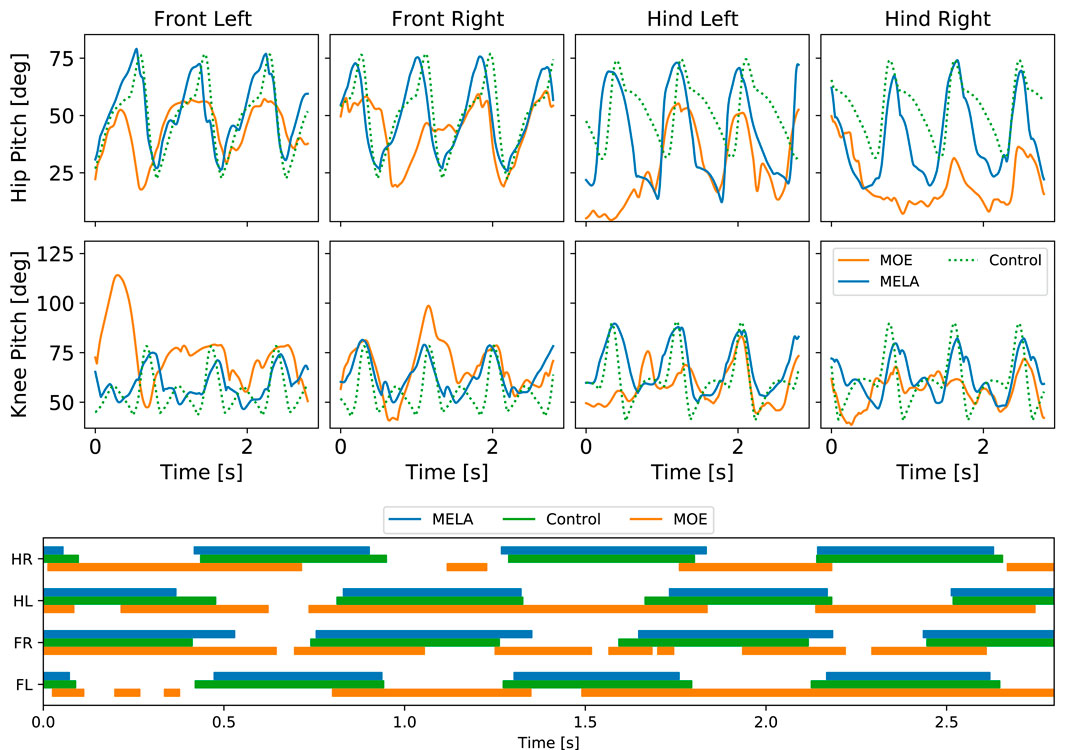
FIGURE 14. Locomotion comparison between control, MoE and MELA. Top: Joint position. Bottom: Gait pattern of Front Left (FL), Front Right (FR), Hind Left (HL), Hind Right (HR) feet.
In addition to the literature (Shazeer et al., 2017; Zhang et al., 2018; Peng et al., 2019), our comparison finds that the low-dimensional latent space of MoE lacks the complexity for encoding sufficient features robust against physical variations, which is needed for a domain transfer of tasks, such as gait recovery and trotting.
In Figure 14, the qualitative differences and similarities among baseline control, MoE and MELA are shown. The baseline control data was used as imitation reference for both MELA and MoE. The average difference of joint positions between baseline control and MELA was 5°, while MoE deviated by 13°. The periodicity and trotting pattern is noticeable in both MELA and baseline control, while MoE was could not reproduce the periodic gait pattern.
We analysed the diversity of skills of MELA and MoE by a t-distributed Stochastic Neighbor Embedding (t-SNE) analysis (Maaten and Hinton, 2008). T-SNE projects high-dimensionals NN activation on a 2D plane by clustering similar NN activations together but keeping dissimilar data points distant, which can be used to analyse robotic behaviours (Yuan et al., 2020).
The experts’ neuron activations (all N experts in Figure 4) during time-step k were stacked as one high-dimensional data point
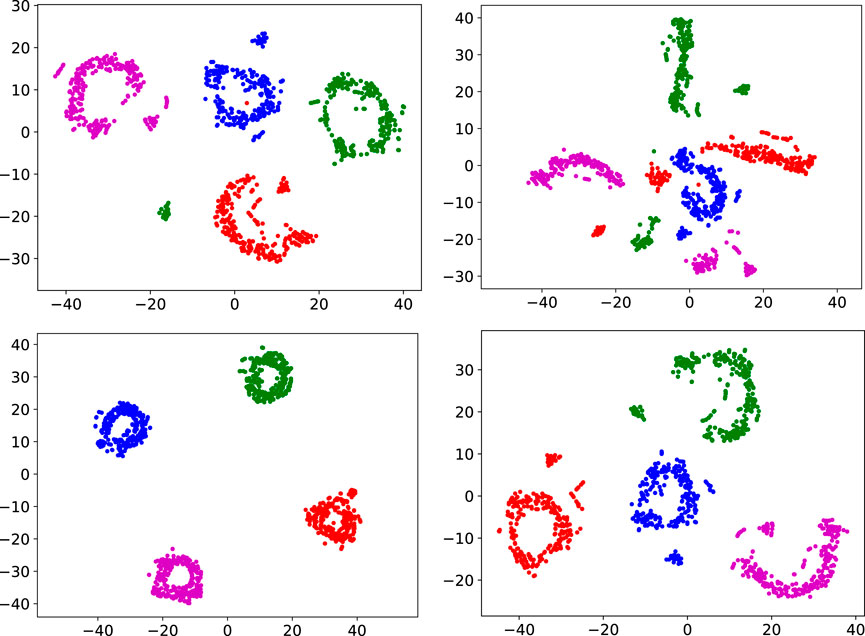
FIGURE 15. Comparison of the t-SNE analysis between MELA and MOE with and without the proposed diversity enforcement, using 4 experts for locomotion (blue and purple) and gait recovery (red and green). Top left: MELA without diversity enforcement, top right: MOE without diversity enforcement, bottom left: MELA with diversity enforcement, bottom right: MOE with diversity enforcement.
Figure 15 shows a t-SNE analysis comparing MELA and MoE with and without the diversity term (19). From the distinct clusters and separation distances (Figure 15 bottom left and right), the diversity among experts using our technique can be seen. MELA shows clustering without the diversity term (Figure 15 top left) and has more distinct expert clusters using the diversity term. For MoE, the experts collapse to one indistinguishable cluster if no diversity term is used (Figure 15 top right) and form four clusters when diversity is enforced (Figure 15 bottom right).
In this work, we proposed: 1) a Multi-Expert Synthesis (MES) framework that can generate motor skills by synthesising expert skills, which is applicable for both robot locomotion and manipulation; 2) an automatic algorithm of selecting relevant physical variables for the state observations of reinforcement learning; and 3) techniques to augment networks and enforce diversify of experts which address the expert imbalance problem in multi-expert approaches.
Both simulation and experiments showed that MES can learn robust quadrupedal locomotion by combining the skills of gait recovery and trotting. Further, MES demonstrated dual-arm manipulation and grasping, where one robot arm pregrasped an object and changed it to a feasible grasp pose, and the other robot arm grasped the object. The robustness of the learned MES policies were rigorously tested by a range of tests in both simulation and real world experiments, which have not been seen during training.
We evaluated two different MES approaches for locomotion and the results were analysed in terms of gait patterns and diversity of experts using a t-SNE analysis. The analysis suggested that our proposed algorithm for state selection was effective allowing locomotion that exhibits the typical gait patterns of quadrupeds, and that our proposed technique enforcing skill diversity between experts indeed removes expert imbalance.
In future work, we plan to expand the MES structure to incorporate visual perception information to allow robot motions that rely on visual inputs. Furthermore, we intend to learn multi-expert policies that combine experts of different morphologies to control various robots with a unified policy.
The raw data supporting the conclusions of this article will be made available by the authors, without undue reservation.
KY conceptualised the MES framework, carried out the software implementation, and conducted the simulations and experiments. KY and ZL designed the experiments and contributed to the manuscript.
This research is supported by the EPSRC CDT in Robotics and Autonomous Systems (EP/L016834/1).
The authors would like to thank Quentin Rouxel and Guiyang Xin for their help and support during the experiments.
The authors declare that the research was conducted in the absence of any commercial or financial relationships that could be construed as a potential conflict of interest.
All claims expressed in this article are solely those of the authors and do not necessarily represent those of their affiliated organizations, or those of the publisher, the editors and the reviewers. Any product that may be evaluated in this article, or claim that may be made by its manufacturer, is not guaranteed or endorsed by the publisher.
The Supplementary Material for this article can be found online at: https://www.frontiersin.org/articles/10.3389/frobt.2022.970890/full#supplementary-material
Barto, A. G., and Mahadevan, S. (2003). Recent advances in hierarchical reinforcement learning. Discrete event Dyn. Syst. 13, 41–77. doi:10.1023/a:1022140919877
Bellicoso, C. D., Jenelten, F., Fankhauser, P., Gehring, C., Hwangbo, J., and Hutter, M. (2017). “Dynamic locomotion and whole-body control for quadrupedal robots,” in 2017 IEEE/RSJ international conference on intelligent robots and systems (IROS) (IEEE), 3359–3365.
Bellicoso, C. D., Jenelten, F., Gehring, C., and Hutter, M. (2018). Dynamic locomotion through online nonlinear motion optimization for quadrupedal robots. IEEE Robot. Autom. Lett. 3, 2261–2268. doi:10.1109/lra.2018.2794620
Chang, X., Hospedales, T. M., and Xiang, T. (2018). “Multi-level factorisation net for person re-identification,” in Proceedings of the IEEE conference on computer vision and pattern recognition (IEEE), 2109–2118.
Clever, D., Harant, M., Mombaur, K., Naveau, M., Stasse, O., and Endres, D. (2017). Cocomopl: A novel approach for humanoid walking generation combining optimal control, movement primitives and learning and its transfer to the real robot hrp-2. IEEE Robot. Autom. Lett. 2, 977–984. doi:10.1109/lra.2017.2657000
Coumans, E., and Bai, Y. (2016). Pybullet, a python module for physics simulation for games, robotics and machine learning. Pybullet.
Dietterich, T. G. (2000). Hierarchical reinforcement learning with the maxq value function decomposition. J. Artif. Intell. Res. 13, 227–303. doi:10.1613/jair.639
Eysenbach, B., Gupta, A., Ibarz, J., and Levine, S. (2018). “Diversity is all you need: Learning skills without a reward function,” in Intern. Conf. On learning representations (IEEE).
Feng, S., Whitman, E., Xinjilefu, X., and Atkeson, C. G. (2015). Optimization-based full body control for the darpa robotics challenge. J. Field Robot. 32, 293–312. doi:10.1002/rob.21559
Frans, K., Ho, J., Chen, X., Abbeel, P., and Schulman, J. (2017). “Meta learning shared hierarchies,” in International conference on representation learning (IEEE).
Garcıa, J., and Fernández, F. (2015). A comprehensive survey on safe reinforcement learning. J. Mach. Learn. Res. 16, 1437–1480.
Ha, S., and Liu, C. K. (2016). “Evolutionary optimization for parameterized whole-body dynamic motor skills,” in 2016 IEEE international conference on robotics and automation (ICRA) (IEEE), 1390–1397.
Haarnoja, T., Zhou, A., Hartikainen, K., Tucker, G., Ha, S., Tan, J., et al. (2018c). Soft actor-critic algorithms and applications. arXiv preprint arXiv:1812.05905.
Haarnoja, T., Hartikainen, K., Abbeel, P., and Levine, S. (2018a). “Latent space policies for hierarchical reinforcement learning,” in International conference on machine learning (IEEE).
Haarnoja, T., Zhou, A., Abbeel, P., and Levine, S. (2018b). “Soft actor-critic: Off-policy maximum entropy deep reinforcement learning with a stochastic actor,” in International conference on machine learning (IEEE).
Hwangbo, J., Lee, J., Dosovitskiy, A., Bellicoso, D., Tsounis, V., Koltun, V., et al. (2019). Learning agile and dynamic motor skills for legged robots. Sci. Robot. 4, eaau5872. doi:10.1126/scirobotics.aau5872
Jacobs, R. A., Jordan, M. I., Nowlan, S. J., and Hinton, G. E. (1991). Adaptive mixtures of local experts. Neural Comput. 3, 79–87. doi:10.1162/neco.1991.3.1.79
Johnson, M., Shrewsbury, B., Bertrand, S., Wu, T., Duran, D., Floyd, M., et al. (2015). Team ihmc’s lessons learned from the darpa robotics challenge trials. J. Field Robot. 32, 192–208. doi:10.1002/rob.21571
Koenig, N., and Howard, A. (2004). “Design and use paradigms for gazebo, an open-source multi-robot simulator,” in 2004 IEEE/RSJ international conference on intelligent robots and systems (IROS)(IEEE cat. No. 04CH37566) (IEEE), 2149–2154.
Kuindersma, S., Deits, R., Fallon, M., Valenzuela, A., Dai, H., Permenter, F., et al. (2016). Optimization-based locomotion planning, estimation, and control design for the atlas humanoid robot. Auton. Robots 40, 429–455. doi:10.1007/s10514-015-9479-3
Kumar, V. C., Ha, S., and Liu, C. K. (2018). “Expanding motor skills using relay networks,” in Conference on robot learning (PMLR), 744–756. https://openreview.net/group?id=robot-learning.org/CoRL/2022/Conference.
Lee, Y., Sun, S.-H., Somasundaram, S., Hu, E. S., and Lim, J. J. (2018). “Composing complex skills by learning transition policies,” in Intern. Conf. On learning representations (IEEE).
Lee, Y., Yang, J., and Lim, J. J. (2019). “Learning to coordinate manipulation skills via skill behavior diversification,” in Intern. Conf. On learning representations (IEEE).
Levine, S., Pastor, P., Krizhevsky, A., Ibarz, J., and Quillen, D. (2018). Learning hand-eye coordination for robotic grasping with deep learning and large-scale data collection. Int. J. Robotics Res. 37, 421–436. doi:10.1177/0278364917710318
Maaten, L. v. d., and Hinton, G. (2008). Visualizing data using t-sne. J. Mach. Learn. Res. 9, 2579–2605.
Merel, J., Ahuja, A., Pham, V., Tunyasuvunakool, S., Liu, S., Tirumala, D., et al. (2018a). “Hierarchical visuomotor control of humanoids,” in International conference on representation learning (IEEE).
Merel, J., Hasenclever, L., Galashov, A., Ahuja, A., Pham, V., Wayne, G., et al. (2018b). “Neural probabilistic motor primitives for humanoid control,” in International conference on representation learning (IEEE).
Mülling, K., Kober, J., Kroemer, O., and Peters, J. (2013). Learning to select and generalize striking movements in robot table tennis. Int. J. Robotics Res. 32, 263–279. doi:10.1177/0278364912472380
Peng, X. B., Abbeel, P., Levine, S., and van de Panne, M. (2018a). Deepmimic: Example-guided deep reinforcement learning of physics-based character skills. ACM Trans. Graph. 37, 1–14. doi:10.1145/3197517.3201311
Peng, X. B., Andrychowicz, M., Zaremba, W., and Abbeel, P. (2018b). “Sim-to-real transfer of robotic control with dynamics randomization,” in 2018 IEEE international conference on robotics and automation (ICRA) (IEEE), 1–8.
Peng, X. B., Chang, M., Zhang, G., Abbeel, P., and Levine, S. (2019). “Mcp: Learning composable hierarchical control with multiplicative compositional policies,” in Advances in neural information processing systems (IEEE), 3686–3697.
Qureshi, A. H., Johnson, J. J., Qin, Y., Henderson, T., Boots, B., and Yip, M. C. (2019). Composing task-agnostic policies with deep reinforcement learning. Conference on Learning Representation. https://openreview.net/.
Rai, A., Antonova, R., Song, S., Martin, W., Geyer, H., and Atkeson, C. (2018). “Bayesian optimization using domain knowledge on the atrias biped,” in 2018 IEEE international conference on robotics and automation (ICRA) (IEEE), 1771–1778.
Shazeer, N., Mirhoseini, A., Maziarz, K., Davis, A., Le, Q., Hinton, G., et al. (2017). “Outrageously large neural networks: The sparsely-gated mixture-of-experts layer,” in International conference on representation learning (IEEE).
Snoek, J., Larochelle, H., and Adams, R. P. (2012). “Practical bayesian optimization of machine learning algorithms,” in Advances in neural information processing systems (IEEE), 2951–2959.
Sun, R., and Peterson, T. (1999). Multi-agent reinforcement learning: Weighting and partitioning. Neural Netw. 12, 727–753. doi:10.1016/s0893-6080(99)00024-6
Sun, Z., Yuan, K., Hu, W., Yang, C., and Li, Z. (2020). “Learning pregrasp manipulation of objects from ungraspable poses,” in International conference on robotics and automation (IEEE).
Sutton, R. S. (1990). “Integrated architectures for learning, planning, and reacting based on approximating dynamic programming,” in Machine learning proceedings 1990 (Elsevier), 216–224.
Sutton, R. S., Precup, D., and Singh, S. (1999). Between mdps and semi-mdps: A framework for temporal abstraction in reinforcement learning. Artif. Intell. 112, 181–211. doi:10.1016/s0004-3702(99)00052-1
Tan, J., Zhang, T., Coumans, E., Iscen, A., Bai, Y., Hafner, D., et al. (2018). “Sim-to-real: Learning agile locomotion for quadruped robots,” in Robotics: Science and systems (IEEE).
Winkler, A. W., Bellicoso, C. D., Hutter, M., and Buchli, J. (2018). Gait and trajectory optimization for legged systems through phase-based end-effector parameterization. IEEE Robot. Autom. Lett. 3, 1560–1567. doi:10.1109/lra.2018.2798285
Yang, C., Yuan, K., Heng, S., Komura, T., and Li, Z. (2020a). Learning natural locomotion behaviors for humanoid robots using human bias. IEEE Robot. Autom. Lett. 5, 2610–2617. doi:10.1109/lra.2020.2972879
Yang, C., Yuan, K., Merkt, W., Komura, T., Vijayakumar, S., and Li, Z. (2018). “Learning whole-body motor skills for humanoids,” in 2018 IEEE-RAS 18th international conference on humanoid robots (humanoids) (IEEE), 270–276.
Yang, C., Yuan, K., Zhu, Q., Yu, W., and Li, Z. (2020b). Multi-expert learning of adaptive legged locomotion. Sci. Robot. 5, eabb2174. doi:10.1126/scirobotics.abb2174
Yuan, K., Chatzinikolaidis, I., and Li, Z. (2019). Bayesian optimization for whole-body control of high-degree-of-freedom robots through reduction of dimensionality. IEEE Robot. Autom. Lett. 4, 2268–2275. doi:10.1109/lra.2019.2901308
Yuan, K., and Li, Z. (2018). “An improved formulation for model predictive control of legged robots for gait planning and feedback control,” in 2018 IEEE/RSJ international conference on intelligent robots and systems (IROS) (IEEE), 1–9.
Yuan, K., McGreavy, C., Yang, C., Wolfslag, W., and Li, Z. (2020). “Decoding motor skills of artificial intelligence and human policies: A study on humanoid and human balance control,” in IEEE robotics and automation magazine (IEEE).
Zhang, H., Starke, S., Komura, T., and Saito, J. (2018). Mode-adaptive neural networks for quadruped motion control. ACM Trans. Graph. 37, 1–11. doi:10.1145/3197517.3201366
Keywords: reinforcement learning, legged robots, manipulation, robotics, robot learning, multi-expert learning, versatile locomotion
Citation: Yuan K and Li Z (2022) Multi-expert synthesis for versatile locomotion and manipulation skills. Front. Robot. AI 9:970890. doi: 10.3389/frobt.2022.970890
Received: 16 June 2022; Accepted: 26 August 2022;
Published: 28 September 2022.
Edited by:
Yan Wu, Institute for Infocomm Research (A∗STAR), SingaporeReviewed by:
Yangwei You, Institute for Infocomm Research (A∗STAR), SingaporeCopyright © 2022 Yuan and Li. This is an open-access article distributed under the terms of the Creative Commons Attribution License (CC BY). The use, distribution or reproduction in other forums is permitted, provided the original author(s) and the copyright owner(s) are credited and that the original publication in this journal is cited, in accordance with accepted academic practice. No use, distribution or reproduction is permitted which does not comply with these terms.
*Correspondence: Zhibin Li, YWxleC5saUB1Y2wuYWMudWs=
Disclaimer: All claims expressed in this article are solely those of the authors and do not necessarily represent those of their affiliated organizations, or those of the publisher, the editors and the reviewers. Any product that may be evaluated in this article or claim that may be made by its manufacturer is not guaranteed or endorsed by the publisher.
Research integrity at Frontiers

Learn more about the work of our research integrity team to safeguard the quality of each article we publish.